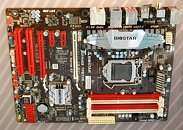Monday, May 31st 2010

Biostar LGA-1155 Socket Motherboards Based on 6-Series Chipsets Spotted
Intel's upcoming Sandy Bridge processor architecture which uses the new LGA-1155 socket seems to be closer than one would think, with motherboard vendors such as Biostar being ready with motherboards that run those processors. The motherboard vendor showed off two socket LGA-1155 motherboards that are based on the Intel P67 and H67 chipsets. The P67 is engineered to be the chipset for processors that need discrete graphics, the chipset lacks the Intel FDI technology needed to connect the processors' embedded graphics controller to display outputs on the motherboard, whereas the H67 does, and is designed for processors with embedded graphics.
The first spot is the TP67XE, based on the P67. This ATX motherboard has all the features of a mid-range performance board. The processor is powered by a 4+2 phase VRM, it is wired to four DDR3 DIMM slots for dual-channel memory. It is said that the Sandy Bridge processors will have higher reference DRAM speeds than present Nehalem/Westmere chips (which have DDR3-1066 and DDR3-1333 depending on the model), expansion slots include one PCI-Express x16, one PCI-E x16 (electrical x4), two PCI-E x1, and two PCI. While the board has padding for a 2-port 3rd party USB 3.0 controller, it is indicated that Intel 6-series chipsets will finally introduce native SATA 6 Gb/s.Next up is the TH67XE, which is based on the H67. This micro-ATX form-factor board includes all the essentials, and looks to get a value market position. A simpler CPU VRM is used, and expansion includes one each of PCI-Express x16, PCI-E x16 (electrical x4), PCI-E x1, and PCI. It features display connectivity. We are probably two quarters away from seeing any concrete signs of LGA-1155 from reaching the market.
Source:
HardwareZone
The first spot is the TP67XE, based on the P67. This ATX motherboard has all the features of a mid-range performance board. The processor is powered by a 4+2 phase VRM, it is wired to four DDR3 DIMM slots for dual-channel memory. It is said that the Sandy Bridge processors will have higher reference DRAM speeds than present Nehalem/Westmere chips (which have DDR3-1066 and DDR3-1333 depending on the model), expansion slots include one PCI-Express x16, one PCI-E x16 (electrical x4), two PCI-E x1, and two PCI. While the board has padding for a 2-port 3rd party USB 3.0 controller, it is indicated that Intel 6-series chipsets will finally introduce native SATA 6 Gb/s.Next up is the TH67XE, which is based on the H67. This micro-ATX form-factor board includes all the essentials, and looks to get a value market position. A simpler CPU VRM is used, and expansion includes one each of PCI-Express x16, PCI-E x16 (electrical x4), PCI-E x1, and PCI. It features display connectivity. We are probably two quarters away from seeing any concrete signs of LGA-1155 from reaching the market.


11 Comments on Biostar LGA-1155 Socket Motherboards Based on 6-Series Chipsets Spotted
Is it just me, or do those boards look ridiculously cheap, ugly and seem to have bad build quality? I mean seriously, no 90 degree SATA-connectors? But then, they are Biostar boards.
If AMD can really nail it with Bulldozer and Fusion, they might just be able to shake Intels position as top dog.
Also as for the boards looking rubbish, it's because they are. They only have 4 power phases. They will only be samples anyway. Wait for Gigabyte or Asus to make a board and then we can see what it will be like.
really,it hasn't been even two years after 1156 was first introduced.Wasn't it supposed to replace Intel's old Core 2 Duo,Quad and etc?I just don't get this,I'll have to wait and see for myself.
Besides, these boards aren't hard to make as all the big changes are contained within the CPU. Not surprising to see them pop up so early.
lol,
so many sockets, intel.. = BAD..